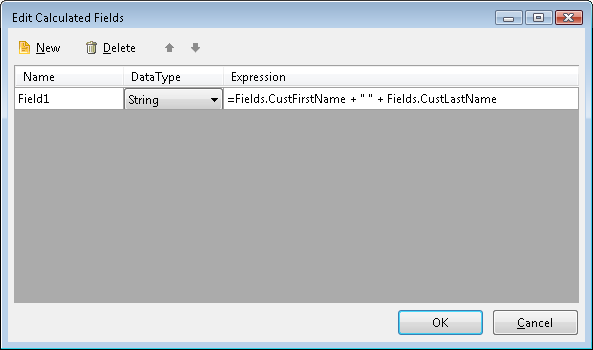Calculated Fields Overview
Calculated fields can be used to create new values that do not exist in the data source. For example, a calculated field can represent a new value, a constant, an expression value, user defined function or even a report parameter, or an existing field that is converted to a different datatype.
You specify a calculated field manually by creating an expression. To open the Edit Calculated Fields dialog:
- Right click on the target DataSource component and select the Properties option from the context menu.
-
Click on the
CalculatedFieldsproperty ellipsis.
The dialog accepts Name , DataType and Expression.
Names must be unique in the datasource and the expression for a calculated field cannot contain aggregates.
Examples:
For example, you can combine text found in two fields. You can create a calculated field that combines the text found in the columns First Name and Last Name, as in the following example (see image above):
| Family Name | First Name | Full Name (Calculated Field) |
|---|---|---|
| Harrington | Mark | Mark Harrington |
| Pak | Jae | Jae Pak |
| Reinhart | Marie | Marie Reinhar |
You can combine the text in the first two columns by entering the following formula for the calculated column:
=Fields.CustFirstName + " " + Fields.CustLastName
You can also create Calculated fields that work with calendar dates. In the following example, the calculated field automatically fills in the date when a business process will be completed. The expression assumes that the process takes seven days to complete.
| Date Submitted | Work Complete (Calculated Field) |
|---|---|
| 12/05 | 12/12 |
| 12/06 | 12/13 |
| 12/07 | 12/1 |
The expression for this calculated field is: =Fields.SubmittedDate.AddDays(CDbl(7))